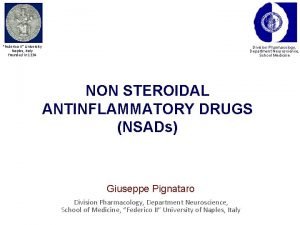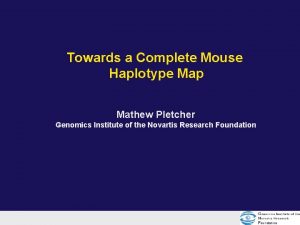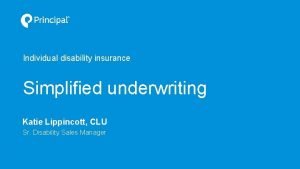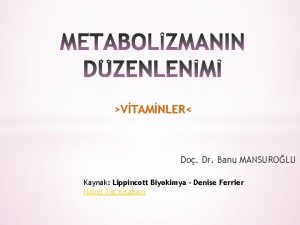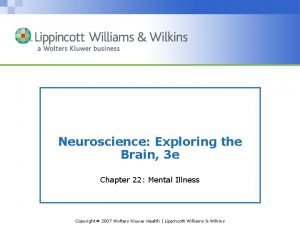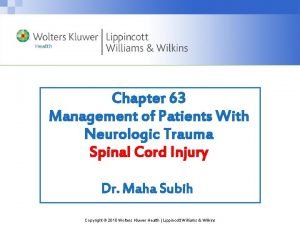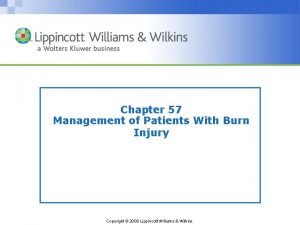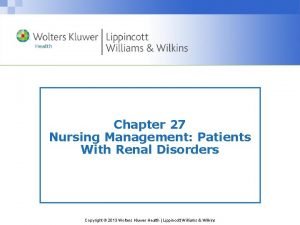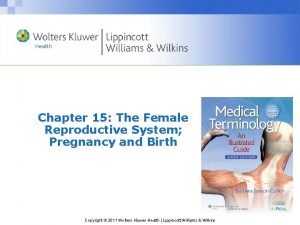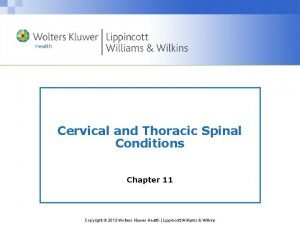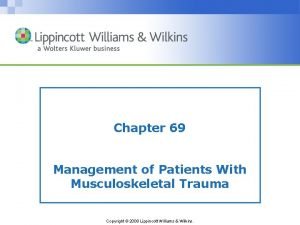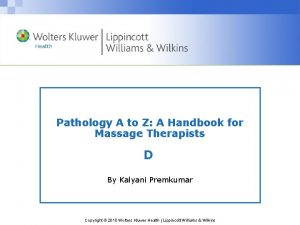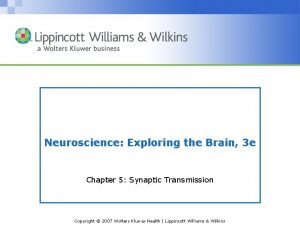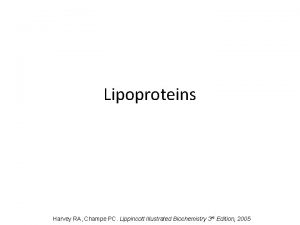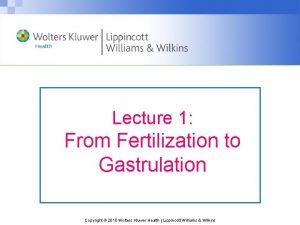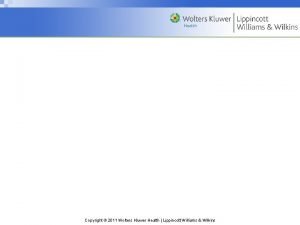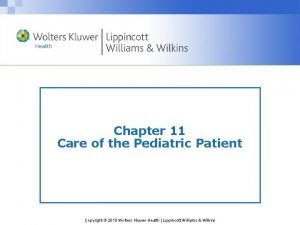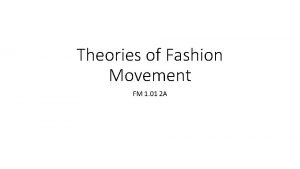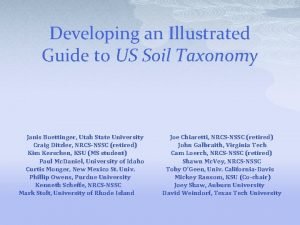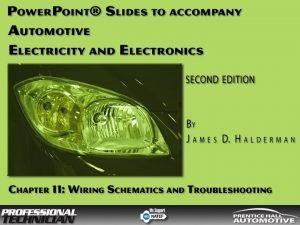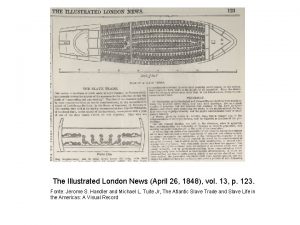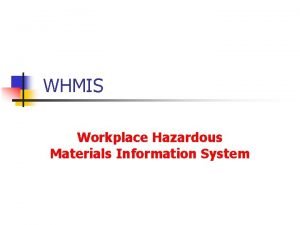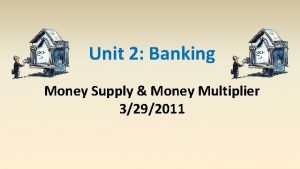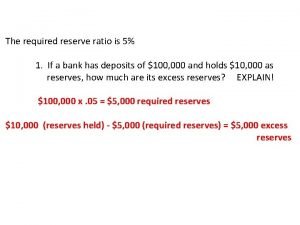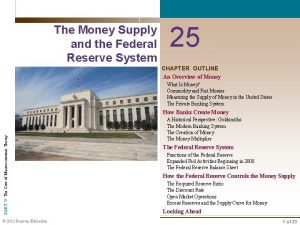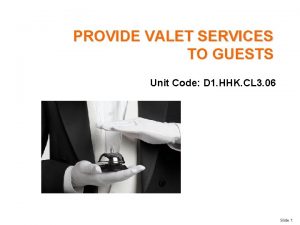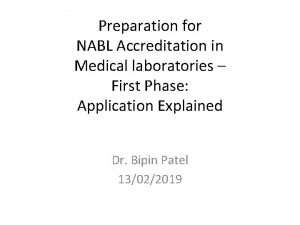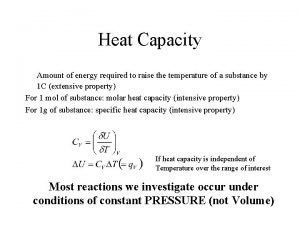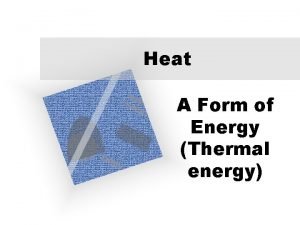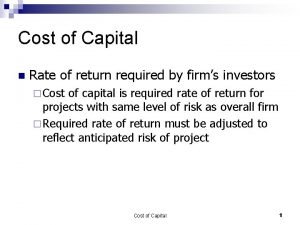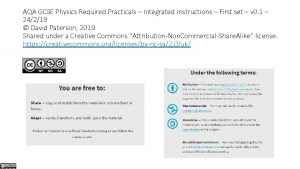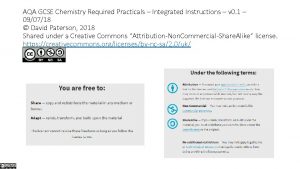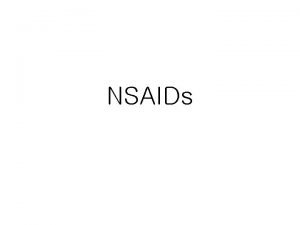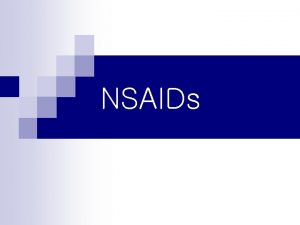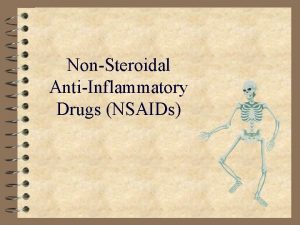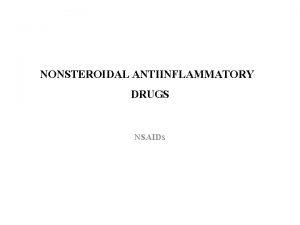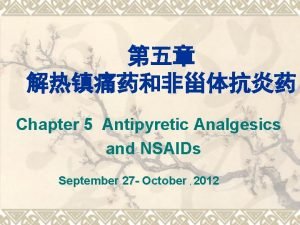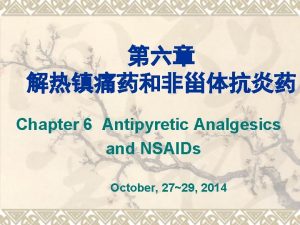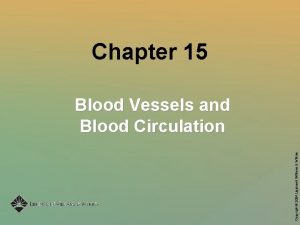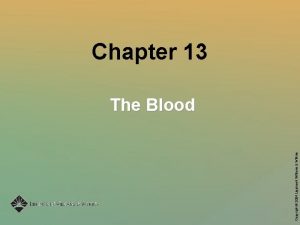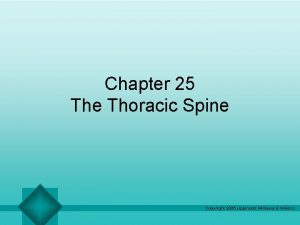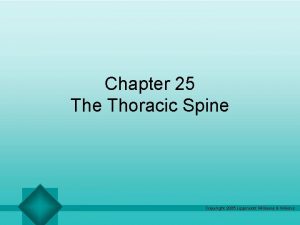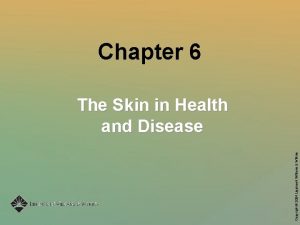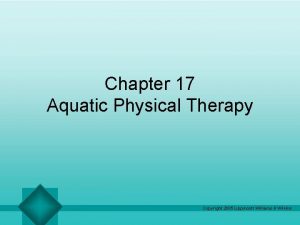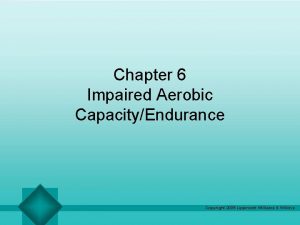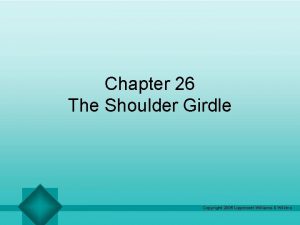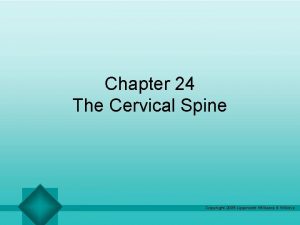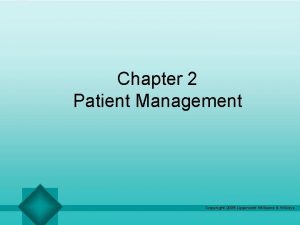NSAIDs 2015 Required reading Chapter 36 Lippincott Illustrated







































































- Slides: 71

NSAIDs 2015. Required reading: Chapter 36, Lippincott Illustrated Reviews: Pharmacology, 6 th ed. 1

Inflammation § Prostaglandins (PGs) – A. Role – B. Synthesis: Cyclooxygenase pathway – C. Actions of PGs – D. Functions in the body – E. Drugs that block PGs § Lipoxygenase pathway: Leukotrienes (LT) 2

3

4

PG PATHWAY Stimulus LT PATHWAY Stimulation or Disturbance of cell membranes Phospholipids Cyclooxygenase COX-1 Prostacyclin Corticosteroids block here Arachidonic Acid Lipoxygenase Thromboxane A 2 Leukotrienes COX-2 LT B C D E Prostaglandins Normal body functions, GI protection, platelet aggregation, vasodilation, ↑ renal GFR & other functions Inflammation 5

Cyclooxygenase pathway: • There are two related isoforms of the cyclooxygenase enzymes. Cyclooxygenase-1 (COX-1) is responsible for the physiologic production of prostanoids (prostaglandin-like substances). • Cyclooxygenase-2 (COX-2) causes the elevated production of prostanoids that occurs in sites of disease and inflammation. • New findings: Certain “good” effects are produced by COX-2, namely renal perfusion. 6

Role of prostaglandins (PGs) as local mediators • Prostaglandins and related compounds are produced in very small quantities by virtually all tissues. • PGs act locally on the tissues in which they are synthesized, & are rapidly metabolized to inactive products at their sites of action. Synthesis of prostaglandins • Arachidonic acid, a 20 -carbon fatty acid, is the primary precursor of the prostaglandins and related compounds. • Arachidonic acid is present as a component of the phospholipids of cell membranes. • Free arachidonic acid is released from tissue phospholipids by the action of phospholipase A 2. • There are two major pathways in the synthesis of the eicosanoids (20 carbon compounds) from arachidonic acid. 7

PGs: Prostaglandins. • COX-1 produces PGs, or prostanoids • COX-1 regulates normal cellular processes, gastric cytoprotection, vascular homeostasis, platelet aggregation, kidney function, renal blood flow, pancreatic beta cell function, outflow of aqueous humor from anterior eye chamber, uterine function, CNS function and many other processes • (Basically the homeostasis of the organism). • COX-1 PGs are called “Constitutive” • Also called “Housekeeping” 8

Cyclooxygenase pathway: • All eicosanoids with ring structures (the prostaglandins, thromboxanes, and prostacyclins)—are synthesized via the cyclooxygenase or cyclic pathway • Cyclooxygenase-1 (COX-1) is responsible for the physiologic production of prostanoids (“housekeeping enzyme” that regulates normal cellular processes, such as gastric cytoprotection, vascular homeostasis, platelet aggregation & inhibition, and kidney function. ) • Cyclooxygenase-2 (COX-2) causes the elevated production of inflammatory prostanoids that occurs in sites of disease and inflammation. • There is some COX-2 in normal tissues, such as the kidneys. COX-2 mediates some normal kidney function. • Therefore, COX-2 inhibition may add risk to the elderly 9

Cyclooxygenase pathway: • The two enzymes share 60 percent homology in amino acid sequence. • However, the conformations for the substrate-binding sites and catalytic regions are slightly different. • For example, COX-2 has a larger and more flexible substrate channel than COX-1 has, and COX-2 has a large space at the site where inhibitors bind. • The expression of COX-1, 2 and LTs is inhibited by glucocorticoids, cortisone-like medications, contributing to the significant anti-inflammatory effects of these drugs. 10

Ibuprofen structure Celecoxib structure Source: Rx List Source: Lippincott Illustrated Reviews: Pharmacology 6 th ed. R Harvey 11

Lipoxygenase pathway: (AKA The “linear” pathway) • Alternatively, lipoxygenase (LOX) can act on arachidonic acid to form unstable derivatives that are converted to the leukotrienes or LTs. • These LTs are responsible for inflammation through a different pathway than the PGs. • They are the Slow-acting Substance of Anaphylaxis. • LTs act in all tissues; their action on their receptors in the role of bronchospasm is the target of drug therapy. • By blocking the receptor for LTD 4, Singulair is effective in decreasing bronchospasm in asthmatic patients. Antileukotriene drugs, such as zileuton, zafirlukast, and Montelukast (Singulair), are useful for the treatment of asthma. 12

Nonsteroidal Anti-Inflammatory Drugs • They inhibit the COX enzymes that catalyze the first step in PG biosynthesis • This leads to decreased PG synthesis • Used to treat O. A. , R. A. , gout, headache, arthralgia, myalgia, & dysmenorrhea. (Mild/moderate pain) • Used in high doses to treat malignancies (e. g. bone CA) • In combination + opioid narcotics: (Lower narcotic doses can be used. ) 13

Nonsteroidal Anti-Inflammatory Drugs • FDA warning on ALL NSAIDS: • CV thrombotic events, MI, stroke, GI, bleeding, ulceration & GI perforation • The elderly are at greater risk • Use with caution in asthmatics: PG inhibition cause a shift to leukotriene production and in 14 crease risk of asthma exacerbations

Nonsteroidal Anti-Inflammatory Drugs, cont. Caution: NSAID/Lithium interaction • Lithium is renally eliminated • NSAIDs inhibit synthesis of renal prostaglandins • Increased risk of retention of sodium and water. • Decreased renal clearance (elimination). • Increased risk of lithium toxicity. • Avoid co-administration. • Acetaminophen: alternative 15

Summary of NSAIDs. As a group, these drugs may increase risk of Myocardial infarction and stroke, with the exception of low-dose aspirin Source: Lippincott Illustrated Reviews 6 th ed. R Harvey 16

Non-Selective COX Inhibitors (Beers list) 17

18

Aspirin ASA Acetylsalicylic acid 19

Another name for cyclooxygenase 20

• PGH 2 Synthase is another name for cyclooxygenase (COX) • ASPIRIN (Acetylsalicylic acid, or ASA): unique NSAID • ASPIRIN irreversibly acetylates & inactivates COX. • Salicylic acid is the active NSAID product, accounting for the major part of the analgesic, antipyretic, and anti -inflammatory actions of ASA. • Doses over 325 mg: BEERS LIST 21

• The other NSAIDs block COX, but are reversible blockers. • On each pass through the liver, they are metabolized and the COX-1 enzyme in platelets is able to produce the PG that would then be acted on by the platelet enzyme, thromboxane synthetase to synthesize thromboxane A 2. This is the reason why NSAIDs, other than ASA, are considered to be reversible platelet aggregation inhibitors. • NSAIDs, by inhibiting COX-1, decrease platelet function; however, it is only ASPIRIN that is used as an anti-platelet drug (81 mg-325 mg/day), as well as an analgesic, antipyretic & anti-inflammatory drug. 22

Aspirin: PG inhibitor, an NSAID • Actions: – Analgesic, Antipyretic, Anti-platelet – GI: Caution: GI bleed. Use enteric-coated tablets – Platelets: Bleeding risk – Kidney: Retention of Na+ and water • Pharmacokinetics • Administration & Distribution – Oral – Rectal – Dosage: Maximum adult dose: 4 g/day 23

Aspirin, continued • Fate: Elimination – Low-dose: First-order kinetics (Concentration dependent) – High-dose: Zero-order kinetics (Time dependent) • Fate: Converted by the liver to water-soluble conjugates that are rapidly cleared by the kidney • Effect on uric acid kidney excretion: To be avoided by patients with gout. • Aspirin interaction with uricosuric: Probenecid (Benemid) 24

Aspirin, continued: Adverse Effects • Reye’s Syndrome in children with viral infections: Salicylates are associated with fatal hepatitis & cerebral edema. Other NSAIDs are NOT associated with this risk • Drug interactions: Warfarin, Phenytoin, Valproic acid, Probenecid, & other NSAIDs • Pregnancy: Category C during trimesters 1 & 2, Category D in trimester 3. • It should be avoided in pregnancy & breast-feeding • ASA & other NSAIDs can cause elevated BP in the elderly hypertensive patient 25

• In children with Kawasaki disease, very high-dose aspirin is used to avoid blood clots and inflammation. • Kawasaki disease, named after the physician that first identified it, is a condition that causes inflammation in the walls of small-and medium-sized arteries throughout the body, including the coronary arteries, which supply blood to the heart muscle. • Kawasaki disease is also called mucocutaneous lymph node syndrome because it also affects lymph nodes, skin, and the mucous membranes inside the mouth, nose and throat. 26

Renal effect of PG synthesis inhibition by NSAIDs Source: Lippincott Illustrated Reviews: Pharmacology 6 th ed. R Harvey 27

Aspirin, continued, Adverse Effects • Aspirin and asthmatics: • By blocking the COX, or cyclic pathway, more arachidonic acid is available for the linear, or LT pathway. • This is the proposed mechanism of “aspirin-allergy” • Patients with Asthma & COPD must avoid Aspirin & other NSAIDs. 28

Aspirin, continued Adverse Effects- Toxicity • Mild: Salicylism: N/V, hyperventilation, headache, mental confusion, dizziness, tinnitus (ringing or roaring sound in the ears) • Large doses: Severe salicylate intoxication, hypoventilation. • Children: Particularly prone to salicylate intoxication. • As little as PO 10 g ASA or 5 m. L of methyl salicylate, as in Bengay ointment, or Oil of Wintergreen cause death in children. • Treatment: 1. Take serum concentrations and p. H. 2. In mild cases, increase urinary p. H. • Serious cases: Dialysis, correction of acid-base & 29 electrolyte imbalances.

Dose dependent effect of salicylates 30 Source: Lippincott Illustrated Reviews 6 th ed. R Harvey

Motrin, Advil, Motrin-IB (Ibuprofen) Rx: 600 -800 mg tabs OTC: 100 mg, 200 mg tabs, Oral susp: 100 mg/5 m. L, Drops: 50 mg/1. 25 m. L (40 mg/m. L), also 200 mg Motrin Migraine Pain Caplets • Blocks cyclo-oxygenase (COX 1 & 2) • After aspirin, the second NSAID • Ibuprofen is used IV in the treatment of patent ductus arteriosus (PDA) in premature neonates (Neo. Profen IV) • Ibuprofen causes less ischemic colitis from PG inhibition compared to indomethacin IV. 31

Patent Ductus Arteriosus (PDA) • Failure of the fetal communication between the pulmonary artery and the aorta to close. • Patency (the state of being open) of the fetal ductus arteriosus is dependent on local PG synthesis. • In delayed closure of the ductus, COX inhibitors can be used to inhibit synthesis of the vasodilating PGs and close the ductus. • Premature infants who develop respiratory distress due to failure of ductus closure can be treated with a high degree of success with I. V. NSAIDs (Ibuprofen or indomethacin). • This precludes the need for surgical closure of the ductus. In certain types of congenital heart disease (transposition of the great arteries, etc), it is important to maintain the patency of the neonate’s ductus before surgery. 32 • This is done with a prostaglandin: alprostadil, PGE 1.

Motrin, Advil, Motrin-IB (Ibuprofen) Cont’d: • Rx: Flexible doses up to 3200 mg/day • OTC (Advil, etc. ) Up to 1200 mg/day • Cautions: Take with food, milk • Risk of increased blood pressure • CV Risks in elderly 33

Naprosyn (Naproxen) Rx: Tabs: 250, 375, 500 mg, E. C. : 375, 500 mg, Susp: 125 mg/5 cc Rx: Anaprox 275 mg Na salt, Anaprox DS 550 mg Na salt Rx: Naprelan 375, 500, 750 mg of naproxen OTC: Aleve: 220 mg Na salt • Dosed B. I. D • Similar to ibuprofen; longer duration of action • Aleve (OTC) ------------------------------------------------------ • Combined with Sumatriptan in Treximet • Strength: 85 mg Sumatriptan +500 mg naproxen sodium 34

Clinoril (Sulindac) Rx: 150 & 200 mg tabs. B. I. D. dosing • Prodrug, converted to active NSAID metabolite, then to an inactive metabolite in the kidneys (Spares adverse renal effects. ) • Caution: Adverse GI effects • PGs in the kidneys are responsible for normal blood flow. NSAIDs that have active metabolites carry the risk of decreasing GFR • Clinoril is used by many nephrologists to treat pain in patients with reduced renal function • It still causes considerable GI upset. It must never be taken TID, only BID. 35

“Oxicam” NSAIDs Mobic (Meloxicam) Rx: 7. 5 & 15 mg tabs (Q. D. ) “Some” preference for COX-2 ----------------------------Feldene (Piroxicam) Rx: 10 & 20 mg capsules • Potent, take with food. NO SUN • Adverse effects: GI, renal (caution: elderly) 36

Indocin (Indomethacin) Rx: Caps 25 & 50 mg, SR 75 mg, Suppositories 50 mg, Oral Susp- 25 mg/5 m. L • Potent NSAID. (BEERS LIST) • Disturbing CNS effects have been reported • P. O. dose 50 mg TID with food: treatment for gouty attack • Used I. V. in the treatment of patent ductus arteriosus (PDA) in premature neonates. (Risk of ischemic colitis). Still used, however ibuprofen I. V. preferred. • Used for pleurisy and effusion associated with rheumatic processes 37

Relafen (Nabumetone) Tabs: 500, 750 mg BID (Take with food) Non-acidic prodrug • Converted to NSAID similar to Naprosyn • Less reported direct GI effects (It is not an acid) • Slightly preferential for COX-2 • Long-term therapy still increases risk of GI effects indirectly by blocking PG-produced high p. H stomach mucus flow 38

Toradol (Ketorolac) Tabs: 10 mg TID, also IM/IV: 15, 30 mg/m. L • Potent NSAID (BEERS LIST) • Monitor GI and renal adverse events • Short term use: for pain (5 days limit - P. O. indicated as continuation of I. V. /I. M. ) • Has a role in pain treatment in patients who are drug-seeking, with history of narcotic drug abuse • Monitor other meds: ASA, NSAIDs 39

Voltaren (Diclofenac Sodium) Voltaren Tabs: 25, 50, 75 mg E. C. (B-TID), Voltaren-XR 100 mg tabs, Ophthalmic Soln, Voltaren topical gel (apply to the skin) Cataflam: 50 mg Potassium salt (Immediate acting) • Hepatotoxicity cautions -------------------------------- • Arthrotec: Diclofenac sodium combined with misoprostol (prostaglandin analog) • PG helps protect gastric mucosa from NSAID damage • Diclofenac sodium/misoprostol: (50/200 & 75/200 mg) 40

Daypro (Oxaprozin) Caplets: 600 mg: Dose: 1200 mg/ QD (Max. 1800 mg/d in divided doses) • Long-acting: Once- a day dosing • When looking for a once a day propionic acid derivative, Daypro would be a good choice 41

Selective COX-2 Inhibitor NOT on BEERS LIST 42

Ibuprofen structure Celecoxib structure Source: Rx List Source: Lippincott Illustrated Reviews: Pharmacology 6 th ed. R Harvey 43

Celebrex (Celecoxib) Capsules: 50, 100, 200 & 400 mg Acute Pain (Adult) & primary dysmenorrhea: Day 1: 400 mg (2 -200 mg capsules) initial dose. Once or twice a day If needed: 200 mg dose on first dose. Subsequent days: 200 mg twice daily PRN • OA (Adult): 200 mg daily • RA (Adult): 100 mg (1 -100 mg capsule) BID to 200 mg (1 -200 mg capsule BID) • Developed to improve GI safety. • However: Clinical trials revealed in increase in M. I. , stroke, and thrombosis. • They depress formation of prostacyclin but do not inhibit COX-1 catalyzed formation of platelet thromboxane Tx. A 2. • Similar mg potency to ibuprofen 44

Celebrex (Celecoxib) Cont’d: • Has a sulfonamide moiety (Caution in people with sulfa allergies) • Counseling- no OTC analgesics with this Rx • General counseling: Diet, exercise, etc. • Also used to treat: § Familial adenomatous polyposis (FAP) 45

Tylenol, Acetaminophen • Non-Salicylate • Non-NSAID • Non-Anti-inflammatory • APAP, N-acetyl-p-aminophenol, Paracetamol 46

Tylenol (APAP, Acetaminophen, N-acetyl-p-aminophenol, Paracetamol) • Inhibits PGs in the CNS, not in periphery • Potent analgesic and antipyretic • Does not affect platelet function • First-line (“First choice”) analgesic in mild to moderate pain and in osteoarthritis (OA) • Effective in treating tension headache • Antipyretic for children (& adults) • Does not antagonize actions of uricosurics • Major organ damage potential: Liver (Hepatotoxicity) • (Skin rash has been rarely reported) 47

• Typical adult dose: 325 to 500 mg PO Q 4 -6 H PRN • If needed, PR suppositories are used: 650 mg PR • MAXIMUM adult dose: 3, 000 mg/day (4, 000 for some generic products) • Doses over 2 g/d may affect vitamin K metabolism and may increase risk of bleed • Patients on warfarin: max: 2 g/d of APAP for pain or fever • Typical PO dose for pain &/or fever in nursing home or hospital: 650 mg IR (2 X 325 mg) crushed, placed in apple sauce and fed to patient, followed by small cup of water. Q 4 -6 h up to max, or PRN. . • Pediatric: Oral suspension: 160 mg/ 5 m. L • Typical pediatric PO dose: 10 -15 mg/kg/dose 48

Analgesic Antipyretic Antiinflammatory Antiplatelet NSAIDs Yes Yes APAP Yes No No Actions of NSAIDs and acetaminophen 49

50 Source: Lippincott Illustrated Reviews: Pharmacology 6 th ed. R Harvey

Under normal circumstances, acetaminophen is conjugated in the liver to form inactive glucuronidated or sulfated metabolites. A portion of acetaminophen is hydroxylated to form Nacetyl-p-benzoiminoquinone (NAPQI)—a highly reactive and potentially dangerous metabolite that reacts with sulfhydryl groups. At normal doses of acetaminophen, the NAPQI reacts with the sulfhydryl group of glutathione, forming a nontoxic substance. Acetaminophen and its metabolites are excreted in the urine. 51

With large doses of acetaminophen, the available glutathione in the liver becomes depleted, and NAPQI reacts with the sulfhydryl groups of hepatic proteins, forming covalent bonds. Hepatic necrosis, a very serious and potentially lifethreatening condition, can result. Et. OH can induce the metabolism of APAP to the toxic metabolite and also cause liver damage, failure and death. (This has been seen with ANY amount of Et. OH) Administration of N-acetylcysteine, Brand name: Mucomyst, which contains sulfhydryl groups to which the toxic metabolite can bind, can be lifesaving if administered within 10 hours of the overdose. Acetaminophen should be avoided in patients with severe hepatic impairment. 52

Products for Skeletal Muscle Spasm 53

Flexeril (Cyclobenzaprine) Tabs: 10 mg-Usually: TID. Maximum dose 60 mg/d, 5 mg tablet (Less drowsiness) • Tricyclic related (Similar to amitriptyline) • Muscle relaxation: from CNS depression • Warning: Constipation, no alcohol • ANTICHOLINERGIC ADVERSE EFFECTS ARE ADDITIVE WHEN TAKEN WITH OTHER ANTISLUD DRUGS 54

Flexeril (Cyclobenzaprine) Cont’d: • Originally indicated for 14 days (or 21) • Flexeril 5 mg has lower incidence of dry mouth (21% vs 32%) and sedation (29% vs 38%) compared to Flexeril 10 mg • 5 mg TID recommended dose for most patients • Has been used in “cocktail” with other meds for its sedative effect 55

Soma (Carisoprodol) (C-IV) Tabs: 350 mg, usually QID (Also 250 mg, Brand only) Soma Compound: (200 mg + 325 mg ASA) (C-IV) Soma Compound w/Codeine (C-III Controlled) (200 mg, 325 mg ASA, 16 mg Codeine Phosphate. ) • Abuse potential (meprobamate is the metabolite) • Muscle relaxation: from CNS depression 56

Soma (Carisoprodol) Cont’d: • Caution: No alcohol, driving cautions • Caution: Highly abused agent • Mixed with Xanax, Valium and/or Vicodin for abuse • Contributes to deaths due to respiratory failure in multiple-drug abusers (Illegal as well as on Rx) 57

Norflex (Orphenadrine Citrate) Tabs: Extended-release, 100 mg IV/IM: 30 mg/m. L • B. I. D. dosing • Related to diphenhydramine • “Muscle relaxation”: (? ) from CNS depression • Caution: No alcohol, driving cautions • (ADR: drowsiness, anti-SLUD effects) 58

Products related to Norflex: • Norgesic (Orphenadrine, ASA, Caffeine: 25 -385 -30 mg) • Norgesic Forte (Orphenadrine, ASA, Caffeine: 50 -770 -60 mg) 59

Skelaxin (Metaxalone) Tabs: 800 mg • Dose: 800 mg TID-QID with food • Muscle relaxant - CNS depression • Take with food to protect stomach • Caution: No alcohol, driving cautions 60

Lioresal (Baclofen) Tabs: 10, 20 mg • Structural analog of GABA, inhibitory neurotransmitter • CNS depressant properties: Sedation, somnolence, ataxia, respiratory depression • This has been involved in cases of drug abuse. (Combined with alcohol or other CNS depressants) 61

Lioresal (Baclofen) Cont’d: • Has been use in skeletal muscle rigidity in parkinsonism, stroke, rheumatic disorders, Tourette syndrome in children, neuropathic pain, migraine prophylaxis, hiccups. • Avoid abrupt discontinuation. Taper down over 1 to 2 weeks, when discontinuing 62

Zanaflex (Tizanidine) Tabs: 2 & 4 mg, Capsules 2, 4, 6 mg. Not interchangeable • Centrally-acting alpha 2 adrenergic agonist (Related to clonidine) • Reduces spasticity by inhibiting presynaptic motor neurons • Widely used. Not as much CNS depression as Soma or Norflex • Indication: Treatment of increased muscle tone associated with spasticity 63

NSAID “Pearls” • The role of lifestyle • Proton Pump Inhibitors (PPIs: Nexium, etc) • Choice of NSAID • The use of more than one NSAID • Combination with narcotics • The “hidden” NSAIDs in OTC products • The pregnant patient: What happens if she takes an OTC NSAID? ? 64

NSAID “Pearls” Continued • The higher incidence of MI in some studies of patients taking COX-2 inhibitor Celebrex (and not taking ASA): • Could be due to loss of cardioprotective or antiplatelet effect that would have been provided by a NON- selective NSAID, such as ibuprofen • However: There is a net cardiovascular risk with all NSAIDs in the elderly 65

NSAID “Pearls” Continued Renal toxicity: • Due to inhibition of renal PGs, all NSAIDs, including selective COX-2 inhibitors, decrease renal blood flow, cause fluid retention and in the elderly may cause renal failure. • People at risk are: fluid depleted (diuretics), cirrhosis, CHF, renally impaired, & elderly. • CAUTION: Lithium toxicity when taken with NSAIDs 66

NSAID Notes • There is a black box warning with all NSAIDs, cautioning about CV and GI risk • They all carry the risk of increased bleeding in patients at risk for this problem • In high doses all NSAIDs can raise blood pressure. • Caution: The lithium interaction. All NSAIDS decrease elimination of lithium. Caution: NSAIDs should not be used in pregnancy. There have been cases of premature closure of the ductus arteriosus in the fetus, resulting in fetal death. (Exception as tocolytic for short time to delay premature labor) • Caution: Some people experience adverse CNS effects: dreams, dysphoria, and atypical behavior 67

NSAID Notes • NOTE: when 81 mg (or whichever dose is used) ASA is taken for antiplatelet action. • If another NSAID is used, such as Advil, the 81 mg ASA must be taken first, allowed to be absorbed, then the NSAID later. • Other NSAIDS, if taken before 81 mg ASA, will bind to the platelet COX, preventing the ASA of irreversibly binding and inhibiting both COX and the formation of Thromboxane A 2. • Outcome of this drug interaction: Loss of antiplatelet effect with increased risk of clot or thromboembolism 68

Nine commonly asked questions concerning the anti-inflammatory effect of the NSAIDs: 1. What dose is required? 2. Is regular use necessary? 3. How is effectiveness determined? 4. Is one drug better than the other, or do some patients respond better to one drug than to others? 5. Will one NSAID work when others have not? 69

Nine commonly asked questions concerning the anti-inflammatory effect of the NSAIDs: 6. How long should one NSAID be tried before it is judged ineffective? 7. Is the effectiveness of an initially successful drug lost with time and continued use? 8. Do NSAIDs alter the course of the disease process being treated? 9. Are combinations of 2 or more different NSAIDs more effective than one alone? 70

References: • Lippincott’s Illustrated Reviews: Pharmacology 6 th ed. R. Harvey • Sigler’s Prescription Drug Cards: SFI Medical Publishing. 30 th edition • The top 100 Drug Interactions, 2015. Hansten & Horn. • Patient Care Management 3 rd edition, R. Finkel, LWW. ISBN: 978 -1 -4511 -1346 -4. 2013. • Clinical Pharmacology: Electronic drug reference and drug therapy management site • Pharmacologic Basis of Therapeutics: Goodman and Gilman, 13 th edition. Medical pharmacology textbook • Mayoclinic. com: Online patient care and health information 71
 Pain goals
Pain goals Nsaids
Nsaids Gastritis x ray
Gastritis x ray Pre reading while reading and post reading activities
Pre reading while reading and post reading activities Lippincot learning
Lippincot learning Franzmarie lippincott
Franzmarie lippincott Katie lippincott
Katie lippincott Wyman gordon
Wyman gordon Lippincott biyokimya
Lippincott biyokimya Lippincott williams & wilkins
Lippincott williams & wilkins Management of patients with neurologic trauma
Management of patients with neurologic trauma 2008
2008 Lippincott williams & wilkins
Lippincott williams & wilkins Lippincott williams & wilkins
Lippincott williams & wilkins Lippincott williams & wilkins
Lippincott williams & wilkins Lippincott nursing advisor
Lippincott nursing advisor Lippincott williams
Lippincott williams Lippincott
Lippincott Lippincott
Lippincott Lippincott williams & wilkins
Lippincott williams & wilkins Lippincott
Lippincott Lippincott williams & wilkins
Lippincott williams & wilkins Wolters kluwer health lippincott williams & wilkins
Wolters kluwer health lippincott williams & wilkins Lippincott
Lippincott 2015 dse pp
2015 dse pp Trickle up fashion theory
Trickle up fashion theory Plot diagram of orpheus
Plot diagram of orpheus Which tropism is best illustrated
Which tropism is best illustrated Illustrated guide to soil taxonomy
Illustrated guide to soil taxonomy Book of revelation illustrated
Book of revelation illustrated The recording process in accounting
The recording process in accounting Two technicians are discussing schematic symbols
Two technicians are discussing schematic symbols Recording process accounting
Recording process accounting Bakit sinasabing tila isang malaking mosaic ang daigdig
Bakit sinasabing tila isang malaking mosaic ang daigdig State the postulate illustrated by the diagram
State the postulate illustrated by the diagram The type of wall decoration illustrated above
The type of wall decoration illustrated above Book of revelation illustrated
Book of revelation illustrated Illustrated london news 1848
Illustrated london news 1848 Round robin reading vs popcorn reading
Round robin reading vs popcorn reading What are the aims of teaching reading
What are the aims of teaching reading Intensive reading characteristics
Intensive reading characteristics What is shared reading
What is shared reading Critical reading
Critical reading Real definition of extensive reading
Real definition of extensive reading Intensive reading and extensive reading
Intensive reading and extensive reading Characteristics of intensive reading
Characteristics of intensive reading Hazardous chemicals
Hazardous chemicals Money multiplier economics
Money multiplier economics Required reserve ratio
Required reserve ratio How to find required reserves
How to find required reserves What is sdb student required info
What is sdb student required info As the safety inventory is increased
As the safety inventory is increased Preparing guest clothes and footwear
Preparing guest clothes and footwear Nabl documents
Nabl documents Organization of hospital pharmacy
Organization of hospital pharmacy Required reserve ratio
Required reserve ratio The amount of energy required
The amount of energy required How to measure heat energy
How to measure heat energy Required rate of return formula
Required rate of return formula Expected rate of return
Expected rate of return Required reserve ratio
Required reserve ratio Alabama boating required equipment
Alabama boating required equipment Aqa a level physics required practicals
Aqa a level physics required practicals Aqa chemistry gcse required practicals
Aqa chemistry gcse required practicals Delivery approaches that accenture recommends
Delivery approaches that accenture recommends Managing uncertainty in supply chain safety inventory
Managing uncertainty in supply chain safety inventory Given that 1 kcal of heat is required
Given that 1 kcal of heat is required Besides being required for diver training
Besides being required for diver training Nwkraft aviation
Nwkraft aviation Rainfall chapter 2
Rainfall chapter 2 Three elements of electricity
Three elements of electricity Required communication performance
Required communication performance

